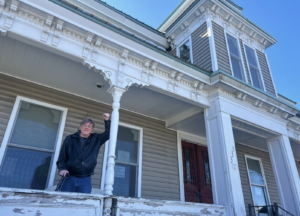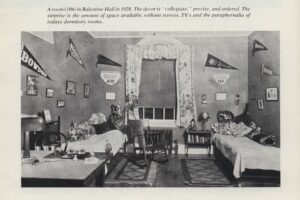Every year, the University of Maine Museum of Art (UMMA) attempts to bring modern and contemporary art to central Maine by highlighting 12 original exhibitions. On Friday, Jan. 18, UMMA invited Meghan Brady, Richard Keen and Zach Horn to share their work with the community in the first three exhibitions of 2019.
Meghan Brady, a painter who lives and works in Midcoast Maine, is notorious for her large scale patchwork pieces. The nine pieces in Brady’s collection “Reversible Roles” range in size and play with bright and uplifting blues, yellows and oranges. One piece, entitled “Everyday” spans 16 feet across and reaches from floor to ceiling. The piece is composed of acrylic collage on unstretched canvas. These pieces confront the audience, enveloping the viewer and demanding interpretation due to their size and color.
“My process is a lot of trial and error,” Brady said. “Recently, I have been better about trusting an acquired logic in my decision making. This logic isn’t something that I could describe clearly but is likely a combination of formal concerns and a learned sense of order, color, light, touch. Basically, I make drawings until the paintings are really cooking. I work in series and so when I am between painting groups, I might spend some time making woodcuts or throwing and glazing pots. I think working in different materials feeds the whole studio project.”
Her inspiration from additional mediums is apparent in her work. They influence her paintings by affecting her manipulation of line and curve, provoking thoughts of ceramics and sculpture.
The show’s second exhibit, “Edging Forward,” highlights the work of Richard Keen, an artist who explores abstraction in both painting and mixed media wall-oriented sculpture. Keen crafts his sculptures with a wide array of materials, frequently using styrofoam, wood, polyester resin and spray enamel. While each of Keen’s 25 pieces are overtly individual, they work together to create an air of curiosity and collaboration.
“I believe that abstraction, in all forms, allows the viewer to bring their own meaning to the conversation and enter a personal dialogue with my work versus presenting them with all the answers about who I am as an artist,” Keen said.
Keen finds inspiration for, and reprieve from, his artwork by diving in boatyards and marinas. He prioritizes time in the outdoors to collect experiences he can reconstruct into art. He believes this method of living maximizes and balances his ability to make art.
“My abstractions always begin from observation,” Keen said. “Whether from the sea as a diver, the landscape as an explorer, or from boats as a source of inspiration, some final works reveal direct connections to my experiences while the origins of others are more disguised. I filter which elements of my experiences are brought into focus by removing unnecessary detail, often simplifying the world into line, shape, color, and texture.”
The third exhibit, “Big Rock Candy Mountain,” features the whimsical work of Zach Horn. The inspiration for his collection came from a desire to create a metaphysical picnic. Each piece dissects and reinterprets different elements of a picnic and allows the audience to piece together the room as one experience. He does this by shifting perspective, altering scale, and manipulating color schemes. In the piece “Spaghetti I,” Horn may seem to have merely painted a bowl of spaghetti. However, he frames the painting with silver plastic forks which shifts the audience’s perception and allows for a more complex interpretation of the piece.
“Big Rock Candy Mountain is wrapped up in my relationship with my kids,” Horn said. “I’m the cook in our house and so part of the way that I express love is through food. Pancakes on Saturdays are statements. My indulgences of my sons’ idiosyncrasies, like giving them an extra plate for syrup, or cutting the pancakes into thin strips, or undercooking the pancakes… are my ways of saying ‘yes’ ‘I love you’ ‘I would do anything for you.’ Spaghetti, besides being beautiful and fun to paint… is what my mother makes for me when she says ‘I love you’. That’s why I have made spaghetti paintings over and over.”
Located at 40 Harlow St. in downtown Bangor, UMMA is free and open to the public Tuesday through Saturday from 10 a.m. to 5 p.m. If you are interested in interpreting these pieces, the three winter exhibits will be on display through May 4, 2019.









